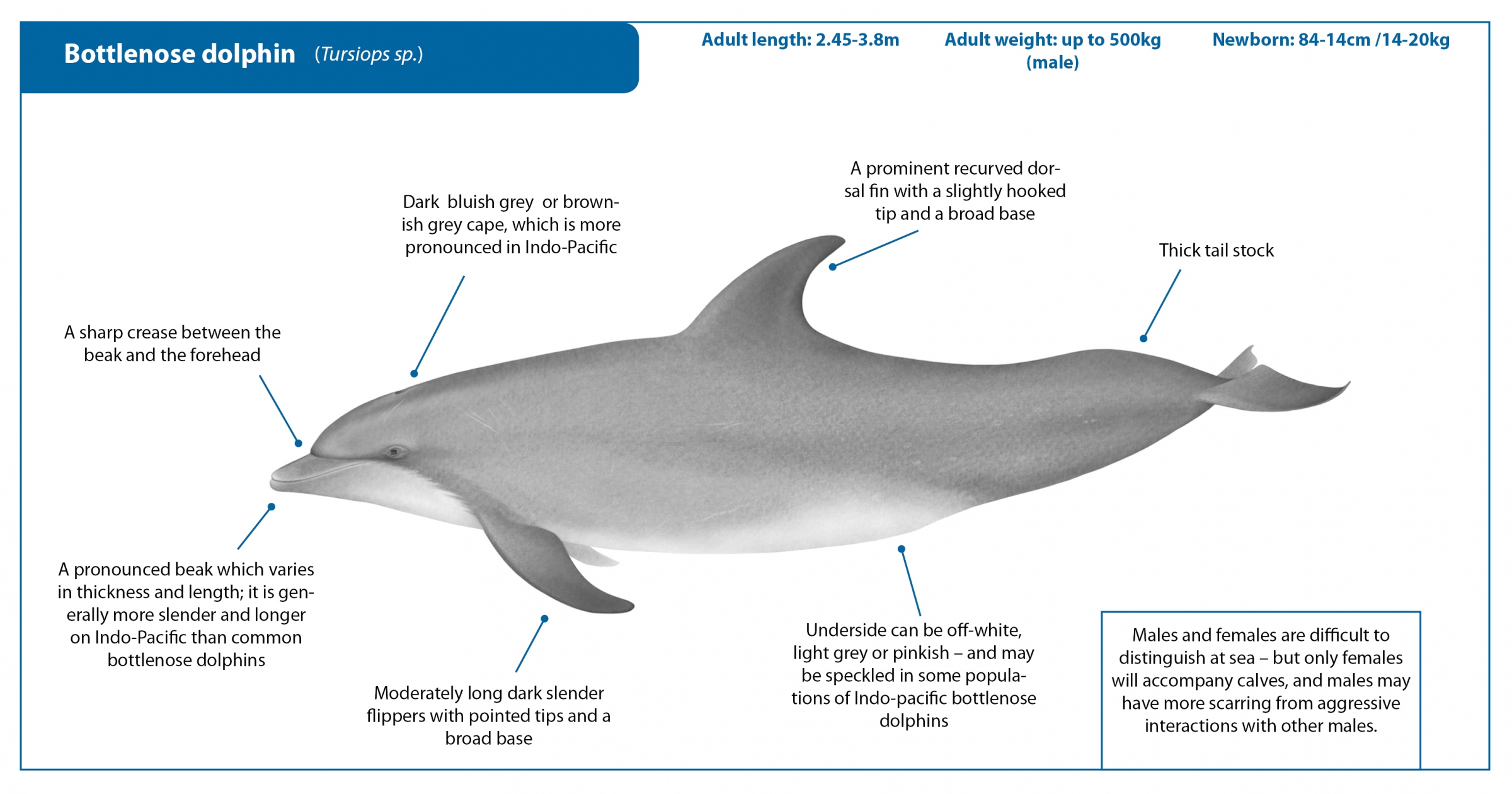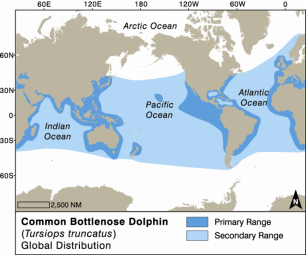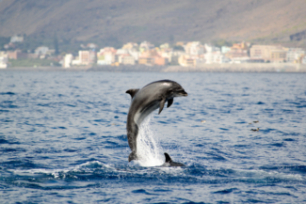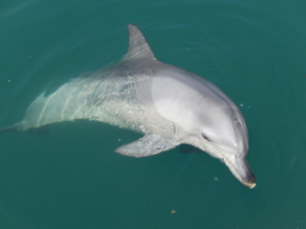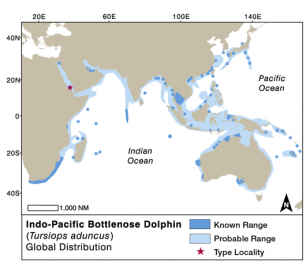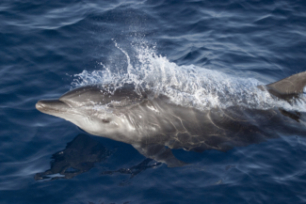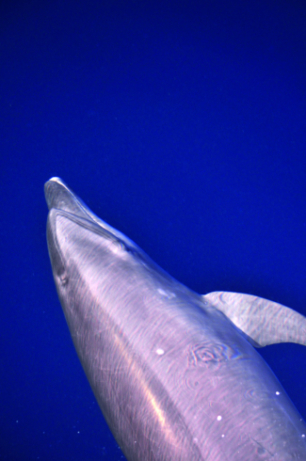Bottlenose dolphins are probably the best-known species of dolphin– the species upon which everyone’s classical image of ‘a dolphin’ is based. The iconic ‘Flipper’, star of television programmes and films since the 1960’s, was a bottlenose dolphin, as are the majority of captive dolphins performing in marine parks around the world. Bottlenose dolphins are found in almost every ocean and sea, other than the coldest waters toward the poles. At present there are two recognized species of bottlenose dolphin, and in some cases, both species can be found in the same area. These are the common bottlenose dolphin (Tursiops truncatus), and the Indo-Pacific bottlenose dolphin (Tursiops aduncus).
In addition to this species distinction (see more details below), there is a great deal of variation between inshore and offshore populations of common bottlenose dolphins in different parts of the world. Populations differ greatly in average length, weight, appendages, external colouration, diet and behaviour. A third possible species -the Burrunan dolphin -has been proposed for inshore populations of bottlenose dolphins in Australia1, and scientists and geneticists around the world have dedicated a great deal of effort to better understanding the taxonomy of bottlenose dolphins. Like humans, different populations inhabit a wide variety of environments, and have adapted special diets, behaviour patterns, and external features to adapt to those habitats2. Wherever they are found, however, bottlenose dolphins tend to be one of the more approachable and active dolphin species, making them a popular target for dolphin watching activities.
References
Show / Hide References
- Charlton-Robb, K. et al. A New Dolphin Species, the Burrunan Dolphin Tursiops australis sp. nov., Endemic to Southern Australian Coastal Waters. PLoS ONE 6, e24047, doi:10.1371/journal.pone.0024047 (2011).
- IWC. Report of the Scientific Committee: Annex M: Report of the Sub-Committee on Small Cetaceans. 40 (International Whaling Commission, Bled, Slovenia, 2017).
- Wells, R. S. & Scott, M. D. Common bottlenose dolphin, Tursiops truncatus, in Encyclopedia of Marine Mammals (eds W. Perrin, B. Wursig, & J.G.M. Thewissen) 249-255 (Elsevier, 2009).
- Jefferson, T. A., Webber, M. A. & Pitman, R. L. Marine Mammals of the World: a Comprehensive Guide to their Identification. Second Edition. (San Diego: Academic Press, 2015).
- Ponnampalam, L. et al. Stomach contents of small cetaceans stranded along the Sea of Oman and Arabian Sea coasts of the Sultanate of Oman. Journal of the Marine Biological Association of the UK 92, 1699-1710 (2012).
- Ross, G. B. G. The smaller cetaceans of the south east coast of Southern Africa. Ann. of the Cape Province Museum (Natural History) 15, 173-410 (1984).
- Wang, J., Y. & Yang, S. C. Indo-Pacific Bottlenose dolphin, Tursiops aduncus, in Encyclopedia of Marine Mammals (ed W. F. Perrin) 602-608 (2009).
- Krützen, M. et al. Cultural transmission of tool use by Indo-Pacific bottlenose dolphins (Tursiops sp.) provides access to a novel foraging niche. Proceedings of the Royal Society B: Biological Sciences 281, doi:10.1098/rspb.2014.0374 (2014).
- Wells, R. S. Social Structure and Life History of Bottlenose Dolphins Near Sarasota Bay, Florida: Insights from Four Decades and Five Generations, in Primates and Cetaceans: Field Research and Conservation of Complex Mammalian Societies (eds Juichi Yamagiwa & Leszek Karczmarski) 149-172 (Springer Japan, 2014).
- Janik, V. M., Sayigh, L. S. & Wells, R. S. Signature whistle shape conveys identity information to bottlenose dolphins. PNAS 103, 8293-8297 (2006).
- Scott, E. M., Mann, J., Watson-Capps, J. J., Sargeant, B. L. & Connor, R. C. Aggression in bottlenose dolphins: evidence for sexual coercion, male-male competition, and female tolerance through analysis of tooth-rake marks and behaviour. Behaviour 142, 21-44 (2005).
- Wells, R. S. Dolphin social complexity: Lessons from long-term study and life history, in Animal Social Complexity: Intelligence, Culture, and Individualized Societies (eds F.B.M. de Waal & P.L. Tyack) 32-56 (Harvard University Press, 2003).
- Marley, S. A., Cheney, B. & Thompson, P. M. Using tooth rakes to monitor population and sex differences in aggressive behaviour in bottlenose dolphins (Tursiops truncatus). Aquatic mammals 39, 107 %@ 0167-5427.
- Corkeron, P. J., Morris, J. G. & Bryden, H. L. Interactions between bottlenose dolphins and sharks in Moreton Bay, Queensland. Aquatic Mammals 13, 109-113 (1987).
- Heithaus, M. R. et al. Spatial variation in shark-inflicted injuries to Indo-Pacific bottlenose dolphins (Tursiops aduncus) of the southwestern Indian Ocean. Marine Mammal Science 33, 335-341, doi:10.1111/mms.12346 (2017).
- Smith, F., Allen, S. J., Bejder, L. & Brown, A. M. Shark bite injuries on three inshore dolphin species in tropical northwestern Australia. Marine Mammal Science, n/a-n/a, doi:10.1111/mms.12435 (2017).
- Amir, O. A., Berggren, P. & Jiddawi, N. S. The incidental catch of dolphins in gillnet fisheries in Zanzibar, Tanzania. Western Indian Ocean Journal of Marine Science 1, 155-162 (2002).
- Friedlaender, A. S., McLellan, W. A. & Pabst, D. A. Characterising an interaction between coastal bottlenose dolphins (Tursiops truncatus) and the spot gillnet fishery in southeastern North Carolina, USA. Journal of Cetacean Research and Management 3, 293-304 (2001).
- Lopez, B. D. Interactions between Mediterranean bottlenose dolphins (Tursiops truncatus) and gillnets off Sardinia, Italy. ICES Journal Marine Science 63, 946-951 (2006).
- Van Waerebeek, K. et al. On the status of the common bottlenose dolphin Tursiops truncatus in western Africa, with emphasis on fisheries interactions, 1947-2015. 20 (2016).
- Wells, R. S. et al. Consequences of injuries on survival and reproduction of common bottlenose dolphins (Tursiops truncatus) along the west coast of Florida. Marine Mammal Science 24, 774-794, doi:10.1111/j.1748-7692.2008.00212.x (2008).
- Adams, J. et al. Land use and the spatial distribution of perfluoroalkyl compounds as measured in the plasma of bottlenose dolphins (Tursiops truncatus). Marine Environmental Research 66, 430–437 (2008).
- Hansen, L. J. et al. Geographic Variation in Polychorinated Biphenyl and Organochlorine Pesticide Concentrations in the Blubber of Bottlenose Dolphins from the U.S. Atlantic Coast. Science of the Total Environment 319, 147-172 (2004).
- Pompe-Gotal, J., Srebocan, E., Gomercic, H. & Prevendar Crnic, A. Mercury concentrations in the tissues of bottlenose dolphins (Tursiops truncatus) and striped dolphins (Stenella coeruloalba) stranded on the Croatian Adriatic coast. Veterinarni Medicina 54, 598-604 (2009).
- Shoham-Frider, E. et al. Persistent organochlorine pollutants and heavy metals in tissues of common bottlenose dolphin (Tursiops truncatus) from the Levantine Basin of the Eastern Mediterranean. Chemosphere 7, 621–627 (2009).
- Wells, R. S. et al. Bottlenose dolphins as marine ecosystem sentinels: Developing a health monitoring system. EcoHealth 1, 246-254 (2004).
- Fire, S. E. et al. Brevetoxin-associated mass mortality event of bottlenose dolphins and manatees along the east coast of Florida, USA. MEPS 526, 241-251 (2015).
- Fire, S. E. et al. Co-occurrence of multiple classes of harmful algal toxins in bottlenose dolphins (Tursiops truncatus) stranding during an unusual mortality event in Texas, USA. Harmful Algae 10, 330–336 (2011).
- Tezanos-Pinto, G. et al. Decline in local abundance of bottlenose dolphins (Tursiops truncatus) in the Bay of Islands, New Zealand. Marine Mammal Science, n/a-n/a, doi:10.1111/mms.12008 (2013).
- Tezanos-Pinto, G., Constantine, R., Mourão, F., Berghan, J. & Scott Baker, C. High calf mortality in bottlenose dolphins in the Bay of Islands, New Zealand–a local unit in decline. Marine Mammal Science 31, 540-559, doi:10.1111/mms.12174 (2015).
- Lusseau, D. L., Slooten, E. & Currey, R. J. C. Unsustainable dolphin-watching tourism in Fjordland, New Zealand. Tourism in Marine Environments 3, 173-178 (2007).
- Christiansen, F. & Lusseau, D. in Whale-watching, sustainable tourism and ecological management. Cambridge University Press, Cambridge, UK (eds J. E. S. Higham, L. Beijder, & R. williams) Ch. 13, 177-192 (Cambridge University Press, 2014).
- Lusseau, D. & Beijder, L. The Long-term Consequences of Short-term Responses to Disturbance Experiences from Whalewatching Impact Assessment. International Journal of Comparative Psychology 20, 228-236 (2007).
- Bejder, L. et al. Decline in relative abundance of bottlenose dolphins exposed to long-term disturbance. Conservation Biology 20, 1791-1798, doi:DOI: 10.1111/j.1523-1739.2006.00540.x (2006).
- Filby, N. E., Stockin, K. A. & Scarpaci, C. Long-term responses of Burrunan dolphins (Tursiops australis) to swim-with dolphin tourism in Port Phillip Bay, Victoria, Australia: A population at risk. Global Ecology and Conservation 2, 62-71, doi:http://dx.doi.org/10.1016/j.ge... (2014).

